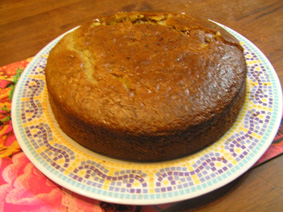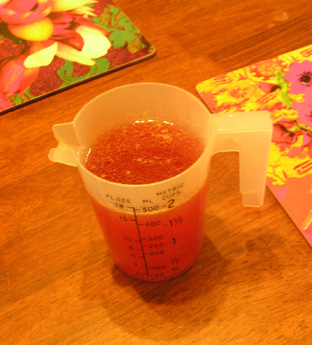 Tonight was our regular fortnightly dinner party with friends who live down the road, and really should have been an excellent excuse to practice wedding cakes. The trouble is, I am currently fighting a psychological battle on the subject of wedding cakes with my more neurotic side, which is claiming – loudly – that it’s terribly unfair to only cater for each kind of allergy with one kind of cake. Everyone should have at least two choices. Out of three kinds of cake. Nobody has actually suggested that I need to do this (in fact, my friends have been very kindly and consistently telling me that I am crazy to think like that), but the delusion persists, so when it came to dessert tonight, I decided to do something utterly-un-wedding-cakely with blood oranges.
Tonight was our regular fortnightly dinner party with friends who live down the road, and really should have been an excellent excuse to practice wedding cakes. The trouble is, I am currently fighting a psychological battle on the subject of wedding cakes with my more neurotic side, which is claiming – loudly – that it’s terribly unfair to only cater for each kind of allergy with one kind of cake. Everyone should have at least two choices. Out of three kinds of cake. Nobody has actually suggested that I need to do this (in fact, my friends have been very kindly and consistently telling me that I am crazy to think like that), but the delusion persists, so when it came to dessert tonight, I decided to do something utterly-un-wedding-cakely with blood oranges.
Ah, blood oranges. I have a rather strange relationship with blood oranges. On the one hand, I love them to bits – their juice is so magnificently red, and they make everything into a chemistry experiment (basically, if you add their juice to anything alkaline, such as, oh, bicarb of soda or egg-whites, the mixture goes a really horrible shade of greenish-greyish-mould-blue, which is actually pretty brilliant, but not so good when you were hoping to serve those cakes to non-scientists). On the other hand… they make everything into a chemistry experiment, which makes me a little wary of using them in baking. After all, even if you cut the egg-whites out of a cake, you do generally need bicarb to make it rise, and most people will not eat bluish-green cake. So I tend to buy huge quantities of these oranges and then dither about using them…
This cake is based on a lime and rosewater syrup cake in Cook Simple. It’s a lovely, easy cake, which I keep adapting to all sorts of flavour combinations just because it is so good and so quick to make, and keeps really well for several days. Blood orange seemed like the logical next step (though ordinary oranges or tangerines would work, too, if you can’t get the bloody kind – this cake was disappointingly sensible in colour), and the orange-flower water syrup was a given, with just a little cardamom to stop everything from getting too cloying. I recommend serving this with Greek yoghurt and poached rhubarb and strawberries, to help cut the richness, though any good, acidic fruit would work.
Your Shopping List
2 blood oranges 2 eggs 150 ml sunflower oil 250 g Greek yoghurt (or soy yoghurt if you need to avoid dairy) 200 g self-raising flour 115 g ground almonds 125 g caster sugar 1 tsp baking powder 3/4 tsp ground cardamom, or to taste 275 ml water 175 g white sugar (or more caster sugar) 2 tsp orange flower water, or to taste 1/4 tsp cardamom (un-ground seeds would be great here, you can strain them out at the end)Now what will you do with it?
Start by lining a 20cm round pan with paper and pre-heating the oven to 180°C.
In a large bowl, beat together your orange zest (save the juice for the syrup and don’t use it here or you really will get green cake) eggs, oil and yoghurt. Sift in the flour, almond meal, baking powder, sugar and cardamom (or just dump them in like I do) and mix everything together well.
Scrape it into your prepared tin, and bake for about half an hour, or until it passes the skewer test.

Note my arty photography, cunningly designed to hide the fact that I was impatient getting the cake out of the tin and the back third of it fell off…
While the cake is baking, prepare the syrup, which you do by putting your lovely, bright red, blood orange juice into a small saucepan with the water, sugar and cardamom seeds. Bring slowly to the boil (you want the sugar to dissolve before this happens), and then let the syrup simmer for about ten minutes. Switch off the heat and add the orange flower water, then strain into a jug to get rid of the cardamom seeds, which provide a lovely flavour but are a bit much to bite into (thus speaks the voice of experience).

Actually, I used ground cardamom, so there was no need to decant the syrup. I just wanted to look at it in a jug because it’s pretty.
When the cake is done, let it cool for ten minutes in the tin, then turn it out onto a plate. Prick little holes all over it with a fork, and then slowly pour the syrup over the top (I do this in batches, to give it a chance to absorb, though it will absorb from the bottom given enough time, even if you pour it all over the cake in one batch so that the cake is sitting in this syrupy puddle).

You can’t *really* see the fallen off bit, can you? The nice thing is that syrup is quite sticky and helps hold it together, despite also making the cake ridiculously soft. I have no idea how it does both those things simultaneously, but am duly grateful.
Serve warm or at room temperature, with Greek yoghurt and fresh or poached fruit. Quick strawberry and rhubarb compote: chop 2 bunches of rhubarb into chunks and hull two punnets of strawberries (NB: this part is much easier if you do not have a cat who is obsessed with strawberries and will do whatever it takes to get to them and if possible rub herself all over them. Mayhem is a seriously weird cat…). Put into a glass baking dish with about 1/3 cup of sugar and some vanilla essence. Cover with foil and bake at 180°C for about 45 minutes or until you can smell that it is cooked. Easy.
Variations
Dairy-free is easy – just use soy yoghurt. I don’t know about making this egg-free; none of the usual substitutes sound as though they would work well here, flavour-wise, so you may need to sit this one out. Sorry. This is also definitely not low-GI, and the obvious gluten-free option is just to use your standard gluten-free flour mix. If you are allergic to nuts, you could take out the almond meal and replace it with flour, though personally, I’d probably go for replacing it with semolina or polenta to get a similarly interesting and moist texture for the syrup.
In terms of flavour variations, the sky is your limit, really. I’ve already made a Coburg Garden Cake variation of this, and really, any citrus will make a good syrup. Use your imagination! I do think this would be gorgeous with poached apricots, which is totally impractical in blood orange season, so you could take your pick of using ordinary oranges in summer or poaching and reconstituting dried apricots in winter (maybe with other dried fruit such as figs and dried cherries, though this might make everything very rich again).
I would also add that this cake is a really excellent one to start with if you aren’t much of a baker – it’s very hard to get wrong if you follow the recipe (I know, that is ridiculous coming from me); there are no difficult processes in it, and about all you could muck up is cooking the syrup at too high a heat so that it boils over or under- or over-cooking the cake. Which, if you start testing at the half hour mark and every 5-10 minutes thereafter, you shouldn’t be able to do. The skewer comes out very clean when this cake is done. So give it a try!
~~~~~~~~~~~~~~~~~~~~~
This time last year…
Making Cheese while the Sun Shines Worth a Thousand Words?


4 comments for “Recipe: Perfumed Blood Orange and Cardamom Cake”